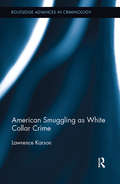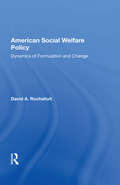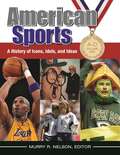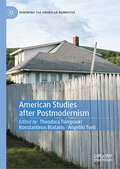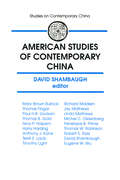- Table View
- List View
American Smuggling as White Collar Crime (Routledge Advances in Sociology #17)
by Lawrence KarsonWhen Edwin Sutherland introduced the concept of white-collar crime, he referred to the respectable businessmen of his day who had, in the course of their occupations, violated the law whenever it was advantageous to do so. Yet since the founding of the American Republic, numerous otherwise respectable individuals had been involved in white-collar criminality. Using organized smuggling as an exemplar, this narrative history of American smuggling establishes that white-collar crime has always been an integral part of American history when conditions were favorable to violating the law.This dark side of the American Dream originally exposed itself in colonial times with elite merchants of communities such as Boston trafficking contraband into the colonies. It again came to the forefront during the Embargo of 1809 and continued through the War of 1812, the Civil War, nineteenth century filibustering, the Mexican Revolution and Prohibition. The author also shows that the years of illegal opium trade with China by American merchants served as precursor to the later smuggling of opium into the United States. The author confirms that each period of smuggling was a link in the continuing chain of white-collar crime in the 150 years prior to Sutherland’s assertion of corporate criminality.
American Social Character: Modern Interpretations
by Rupert WilkinsonThis anthology features the writings of 17 important analysts of American character and culture. From 1945 to the present, this book includes selections by Charles Reich, Christopher Lasch, Philip Slater and many others. There is a general introduction to the subject and each selection is preceded by an introduction and followed by a critical comme
American Social Character: Modern Interpretations
by Rupert WilkinsonThis anthology features the writings of 17 important analysts of American character and culture. From 1945 to the present, this book includes selections by Charles Reich, Christopher Lasch, Philip Slater and many others. There is a general introduction to the subject and each selection is preceded by an introduction and followed by a critical comme
American Social Welfare Policy: Dynamics Of Formulation And Change
by David RochefortSocial welfare activities stand at the heart of the modern democratic state as they absorb ever-increasing budget allocations and stimulate debate over the proper role of government. This study analyzes the development of social welfare policy in modern America, beginning with a critical assessment of the dominant "progressive and "social control t
American Social Welfare Policy: Dynamics Of Formulation And Change
by David RochefortSocial welfare activities stand at the heart of the modern democratic state as they absorb ever-increasing budget allocations and stimulate debate over the proper role of government. This study analyzes the development of social welfare policy in modern America, beginning with a critical assessment of the dominant "progressive and "social control t
American Socialist Triptych: The Literary-Political Work of Charlotte Perkins Gilman, Upton Sinclair, and W. E. B. Du Bois (Class : Culture)
by Mark Van WienenAmerican Socialist Triptych: The Literary-Political Work of Charlotte Perkins Gilman, Upton Sinclair, and W. E. B. Du Bois explores the contributions of three writers to the development of American socialism over a fifty--year period and asserts the vitality of socialism in modern American literature and culture. Drawing upon a wide range of texts including archival sources, Mark W. Van Wienen demonstrates the influence of reform-oriented, democratic socialism both in the careers of these writers and in U.S. politics between 1890 and 1940. While offering unprecedented in-depth analysis of modern American socialist literature, this book charts the path by which the supposedly impossible, dangerous ideals of a cooperative commonwealth were realized, in part, by the New Deal. American Socialist Triptych provides in-depth, innovative readings of the featured writers and their engagement with socialist thought and action. Upton Sinclair represents the movement's most visible manifestation, the Socialist Party of America, founded in 1901; Charlotte Perkins Gilman reflects the socialist elements in both feminism and 1890s reform movements, and W. E. B. Du Bois illuminates social democratic aspirations within the NAACP. Van Wienen's book seeks to re-energize studies of Sinclair by treating him as a serious cultural figure whose career peaked not in the early success of The Jungle but in his nearly successful 1934 run for the California governorship. It also demonstrates as never before the centrality of socialism throughout Gilman's and Du Bois's literary and political careers. More broadly, American Socialist Triptych challenges previous scholarship on American radical literature, which has focused almost exclusively on the 1930s and Communist writers. Van Wienen argues that radical democracy was not the phenomenon of a decade or of a single group but a sustained tradition dispersed within the culture, providing a useful genealogical explanation for how socialist ideas were actually implemented through the New Deal. American Socialist Triptych also revises modern American literary history, arguing for the endurance of realist and utopian literary modes at the height of modernist literary experimentation and showing the importance of socialism not only to the three featured writers but also to their peers, including Edward Bellamy, Hamlin Garland, Jack London, Edna St. Vincent Millay, and Claude McKay. Further, by demonstrating the importance of social democratic thought to feminist and African American campaigns for equality, the book dialogues with recent theories of radical egalitarianism. Readers interested in American literature, U.S. history, political theory, and race, gender, and class studies will all find in American Socialist Triptych a valuable and provocative resource.
American Sociological Theory: A Critical History
by Robert BierstedtAmerican Sociological Theory: A Critical History discusses the history of American sociological theory by providing a selective and critical account of ten writers largely involved in the subject. Chapters 1 to 10 of this book are devoted to the contributions and investigations of ten acclaimed sociological theorists— William Graham Sumner, Lester Frank Ward, Charles Horton Cooley, Edward Alsworth Ross, Florian Znaniecki, Robert Morrison Maclver, Pitirim A. Sorokin, George A. Lundberg, Talcott Parsons, and Robert K. Merton. The sociological label, legacy of Spencer, normative taboo, American references, and the ""Holy Trinity"" (Marx, Durkheim, and Weber) are also elaborated in this text. This publication is a good reference for students and researchers conducting work on general sociological theory.
American Sociology: From Pre-Disciplinary to Post-Normal (Sociology Transformed)
by S. TurnerAmerican Sociology has changed radically since 1945. This volume traces these changes to the present, with special emphasis on the feminization of sociology and the decline of the science ideal as well as the challenges sociology faces in the new environment for universities.
The American Southwest and Mesoamerica: Systems of Prehistoric Exchange (Interdisciplinary Contributions to Archaeology)
by Jonathon E. Ericson Timothy G. BaughRegional approaches to the study of prehistoric exchange have generated much new knowledge about intergroup and regional interaction. The American South west and Mesoamerica: Systems of Prehistoric Exchange is the first of two volumes that seek to provide current information regarding regional exchange on a conti nental basis. From a theoretical perspective, these volumes provide important data for the comparative analysis of regional systems relative to sociopolitical organization from simple hunter-gatherers to those of complex sociopolitical entities like the state. Although individual regional exchange systems are unique for each region and time period, general patterns emerge relative to sOciopolitical organization. Of significant interest to us are the dynamic processes of change, stability, rate of growth, and collapse of regional exchange systems relative to sociopolitical complexity. These volumes provide basic data to further our under standing of prehistoric exchange systems. The volume presents our current state of knowledge about regional exchange systems in the American Southwest and Mesoamerica. Each chapter synthesizes the research findings of a number of other researchers in order to provide a synchronic view of regional interaction for a specific chronological period. A diachronic view is also prOvided for regional interaction in the context of the developments in regional SOciopolitical organization. Most authors go beyond description by proposing alternative models within which to understand regional interaction. The book is organized by geographical and chronological divisions to pro vide units of the broader mosaic of prehistoric exchange systems.
American Space/American Place: Geographies of the Contemporary United States
by John A. Agnew Jonathan M. SmithAmerican Space/American Place offers geographical perspectives on the condition of the United States at the outset of the twenty-first century. It compares the American ideal of liberty, equality, individual opportunity and social improvement with the contemporary condition of the regions, states and localities--the ideal American space with its reality as a place. It uses the public standard provided by the official ideology of the United States to see how well things are really going. Agnew and Smith consider the contrast between ideal and reality at local, state and national levels in education, health, and welfare, in community, race, gender, and calss relations, in economic and industrial development, and in the use and exploitation of America's landscape. American Space/American Place provides a series of compelling insights into the current condition of American Society, its natural environment and its place within the world.
American Space/American Place: Geographies of the Contemporary United States
by John Agnew Jonathan M. SmithAmerican Space/American Place offers geographical perspectives on the condition of the United States at the outset of the twenty-first century. It compares the American ideal of liberty, equality, individual opportunity and social improvement with the contemporary condition of the regions, states and localities--the ideal American space with its reality as a place. It uses the public standard provided by the official ideology of the United States to see how well things are really going. Agnew and Smith consider the contrast between ideal and reality at local, state and national levels in education, health, and welfare, in community, race, gender, and calss relations, in economic and industrial development, and in the use and exploitation of America's landscape. American Space/American Place provides a series of compelling insights into the current condition of American Society, its natural environment and its place within the world.
American Sport in International History: The United States and the World since 1865 (New Approaches to International History)
by Daniel M. DuBoisThis book explores how American sports, especially basketball, baseball and American football, have projected the US into the world, and brought the world into America. Taking a chronological approach it traces the development of American sports from the turn of the 20th century, highlighting how international forces such as immigration, geopolitics and war have influenced the trajectory of sport in the US, and thus the American experience. DuBois also considers the globalization of American sport and how this soft power shaped international relations throughout the American century. Addressing key questions about the role of sport in the rise of the United States, it frames themes that have come to define sports history; gender, race, economics and politics. It argues that while sport has not necessarily been a catalyst for change, it has often mirrored social issues, and sometimes served as an important tool of progress. Synthesizing major works alongside primary sources, the chapters study boxing, hockey, track and field and soccer alongside the 'big three' (basketball, baseball and American football) through a number of case studies to offer a novel interpretation of American sport history. Spanning early Native American sport, the export of baseball in the American empire, the role of basketball in the Cold War, the influence of immigrants and women in sports, and modern day sport culture, American Sport in International History asks what the role of sport has been and will be in a shifting international environment.
American Sport in International History: The United States and the World since 1865 (New Approaches to International History)
by Daniel M. DuBoisThis book explores how American sports, especially basketball, baseball and American football, have projected the US into the world, and brought the world into America. Taking a chronological approach it traces the development of American sports from the turn of the 20th century, highlighting how international forces such as immigration, geopolitics and war have influenced the trajectory of sport in the US, and thus the American experience. DuBois also considers the globalization of American sport and how this soft power shaped international relations throughout the American century. Addressing key questions about the role of sport in the rise of the United States, it frames themes that have come to define sports history; gender, race, economics and politics. It argues that while sport has not necessarily been a catalyst for change, it has often mirrored social issues, and sometimes served as an important tool of progress. Synthesizing major works alongside primary sources, the chapters study boxing, hockey, track and field and soccer alongside the 'big three' (basketball, baseball and American football) through a number of case studies to offer a novel interpretation of American sport history. Spanning early Native American sport, the export of baseball in the American empire, the role of basketball in the Cold War, the influence of immigrants and women in sports, and modern day sport culture, American Sport in International History asks what the role of sport has been and will be in a shifting international environment.
American Sports [4 volumes]: A History of Icons, Idols, and Ideas [4 volumes]
by Murry R. NelsonAmerica loves sports. This book examines and details the proof of this fascination seen throughout American society—in our literature, film, and music; our clothing and food; and the iconography of the nation.This momentous four-volume work examines and details the cultural aspects of sport and how sport pervasively reflects—and affects—myriad aspects of American society from the early 1900s to the present day. Written in a straightforward, readable manner, the entries cover both historical and contemporary aspects of sport and American culture. Unlike purely historical encyclopedias on sports, the contributions within these volumes cover related subject matter such as poetry, novels, music, films, plays, television shows, art and artists, mythologies, artifacts, and people.While this encyclopedia set is ideal for general readers who need information on the diverse aspects of sport in American culture for research purposes or are merely reading for enjoyment, the detailed nature of the entries will also prove useful as an initial source for scholars of sport and American culture. Each entry provides a number of both print and online resources for further investigation of the topic.
American Studies after Postmodernism (Renewing the American Narrative)
by Theodora Tsimpouki Konstantinos Blatanis Angeliki TsetiThis book explores the major challenges that the long-standing and diversely debated demise of postmodernism signifies for American literature, art, culture, history, and politics, in the present, third decade of the twenty-first century. Its scope comprises a vigorous discussion of all these diverse fields undertaken by distinguished scholars as well as junior researchers, U.S. Americanists and European Americanists alike. Focusing on socio-political and cultural developments in the contemporary U.S., their contributions highlight the interconnectedness of the geopolitical, economic, environmental and technological crises that define the historical present on global scale. Chapter 16 is available open access under a Creative Commons Attribution 4.0 International License via link.springer.com.
American Studies oder Amerikanistik?: Die deutsche Amerikawissenchaft und die Hoffnung auf Erneuerung der Hochschulen und der politischen Kultur nach 1945 (Forschung Politik #26)
by Gisela StrunzDas Buch geht der Frage nach, welche Hoffnungen die amerikanischen Militärbehörden mit der Einführung der American Studies an den westdeutschen Universitäten verbanden und wie die konkrete Umsetzung dieses Experiments auf amerikanischer und deutscher Seite aussah.
American Studies of Contemporary China
by David L. ShambaughExamines the historical evolution of contemporary China studies in the United States, reflecting the growth and maturation of the field since the Communist Party seized power in 1949.
American Studies of Contemporary China (Studies On Contemporary China)
by David L. ShambaughExamines the historical evolution of contemporary China studies in the United States, reflecting the growth and maturation of the field since the Communist Party seized power in 1949.
The American Surveillance State: How the U.S. Spies on Dissent
by David H. PriceWhen the possibility of wiretapping first became known to Americans they were outraged. Now, in our post 9/11 world, it’s accepted that corporations are vested with human rights, and government agencies and corporations use computers to monitor our private lives. David H. Price pulls back the curtain to reveal how the FBI and other government agencies have always functioned as the secret police of American capitalism up to today, where they luxuriate in a near-limitless NSA surveillance of all.Price looks through a roster of campaigns by law enforcement, intelligence agencies and corporations to understand how we got here. Starting with J. Edgar Hoover and the early FBI’s alignment with business, his access to 15,000 pages of never-before-seen FBI files shines a light on the surveillance of Edward Said, Andre Gunder Frank and Alexander Cockburn, Native American communists and progressive factory owners.Price uncovers patterns of FBI monitoring and harassing of activists and public figures, providing the vital means for us to understanding how these new frightening surveillance operations are weaponised by powerful governmental agencies that remain largely shrouded in secrecy.
American Sutra: A Story of Faith and Freedom in the Second World War
by Duncan Ryūken WilliamsA Los Angeles Times Bestseller “Raises timely and important questions about what religious freedom in America truly means.” —Ruth Ozeki “A must-read for anyone interested in the implacable quest for civil liberties, social and racial justice, religious freedom, and American belonging.” —George Takei On December 7, 1941, as the bombs fell on Pearl Harbor, the first person detained was the leader of the Nishi Hongwanji Buddhist sect in Hawai‘i. Nearly all Japanese Americans were subject to accusations of disloyalty, but Buddhists aroused particular suspicion. From the White House to the local town council, many believed that Buddhism was incompatible with American values. Intelligence agencies targeted the Buddhist community, and Buddhist priests were deemed a threat to national security. In this pathbreaking account, based on personal accounts and extensive research in untapped archives, Duncan Ryūken Williams reveals how, even as they were stripped of their homes and imprisoned in camps, Japanese American Buddhists launched one of the most inspiring defenses of religious freedom in our nation’s history, insisting that they could be both Buddhist and American. “A searingly instructive story…from which all Americans might learn.” —Smithsonian “Williams’ moving account shows how Japanese Americans transformed Buddhism into an American religion, and, through that struggle, changed the United States for the better.” —Viet Thanh Nguyen, author of The Sympathizer “Reading this book, one cannot help but think of the current racial and religious tensions that have gripped this nation—and shudder.” —Reza Aslan, author of Zealot
American Tabloid Media and the Satanic Panic, 1970-2000 (Palgrave Historical Studies in Witchcraft and Magic)
by Sarah A. HughesThis book examines the “satanic panic” of the 1980s as an essential part of the growing relationship between tabloid media and American conservative politics in the 1980s. It argues that widespread fears of Satanism in a range of cultural institutions was indispensable to the development and success of both infotainment, or tabloid content on television, and the rise of the New Right, a conservative political movement that was heavily guided by a growing coalition of influential televangelists, or evangelical preachers on television. It takes as its particular focus the hundreds of accusations that devil-worshippers were operating America’s white middle-class suburban daycare centers. Dozens of communities around the country became embroiled in trials against center owners, the most publicized of which was the McMartin Preschool trial in Manhattan Beach, California. It remains the longest and most expensive criminal trial in the nation’s history.
American Taboo: The Forbidden Words, Unspoken Rules, and Secret Morality of Popular Culture
by Lauren RosewarneAmerica's often-unspoken morality codes make many topics taboo in "the land of the free." This book analyzes hundreds of popular culture examples to expose how the media both avoids and alludes to how we derive pleasure from our bodies.Flatulence … male nudity … abortion … masturbation: these are just a few of the taboo topics in the United States. What do culturally enforced silences about certain subjects say about our society—and our latent fears? This work provides a broad yet detailed overview of popular culture's most avoided topics to explain why they remain off-limits and examines how they are presented in contemporary media—or, in many cases, delicately explored using euphemism and innuendo. The author offers fascinating, in-depth analysis of the meaning behind these portrayals of a variety of both mundane and provocative taboos, and identifies how new television programs, films, and advertising campaigns intentionally violate longstanding cultural taboos to gain an edge in the marketplace.
American Taboo: The Forbidden Words, Unspoken Rules, and Secret Morality of Popular Culture
by Lauren RosewarneAmerica's often-unspoken morality codes make many topics taboo in "the land of the free." This book analyzes hundreds of popular culture examples to expose how the media both avoids and alludes to how we derive pleasure from our bodies.Flatulence … male nudity … abortion … masturbation: these are just a few of the taboo topics in the United States. What do culturally enforced silences about certain subjects say about our society—and our latent fears? This work provides a broad yet detailed overview of popular culture's most avoided topics to explain why they remain off-limits and examines how they are presented in contemporary media—or, in many cases, delicately explored using euphemism and innuendo. The author offers fascinating, in-depth analysis of the meaning behind these portrayals of a variety of both mundane and provocative taboos, and identifies how new television programs, films, and advertising campaigns intentionally violate longstanding cultural taboos to gain an edge in the marketplace.
American Tantalus: Horizons, Happiness, and the Impossible Pursuits of US Literature and Culture
by Andrew WarnesAmerican Tantalus argues that modern US fictions often grow preoccupied by tantalisation. This keyword might seem commonplace; thesauruses, certainly, often lump it in with tease and torment in their general inventories of desire. Such lists, however, mislead. Just as most US dictionaries have in fact long recognised tantalise's origins in The Odyssey, so they have defined it as the unique desire we feel for objects that (like the fruit and water once cruelly placed before Tantalus) lie within our reach yet withdraw from our attempts to touch them. On these terms, American Tantalus shows, tantalise not only describes a particular kind of thwarted desire, but also one that dominates modern US fiction to a remarkable extent. For this term specifically evokes the yearning to touch alienated or virginal objects that we find examined by F. Scott Fitzgerald, Toni Cade Bambara, Richard Wright and Toni Morrison; and it also indicates the insatiable pursuit of the horizon so important to Willa Cather and Edith Wharton among others. This eclectic canon indeed "prefers" the dictionary to the thesaurus: unreachable destinations and untouched commodities here indeed tantalise, inviting gestures of inquiry from which they then recoil. This focus, while lodging cycles of tantalisation at the very heart of American myth, holds profound implications for our understanding of modernity, and, in particular, of the cultural genesis of the commodity as a form.
American Tantalus: Horizons, Happiness, and the Impossible Pursuits of US Literature and Culture
by Andrew WarnesAmerican Tantalus argues that modern US fictions often grow preoccupied by tantalisation. This keyword might seem commonplace; thesauruses, certainly, often lump it in with tease and torment in their general inventories of desire. Such lists, however, mislead. Just as most US dictionaries have in fact long recognised tantalise's origins in The Odyssey, so they have defined it as the unique desire we feel for objects that (like the fruit and water once cruelly placed before Tantalus) lie within our reach yet withdraw from our attempts to touch them. On these terms, American Tantalus shows, tantalise not only describes a particular kind of thwarted desire, but also one that dominates modern US fiction to a remarkable extent. For this term specifically evokes the yearning to touch alienated or virginal objects that we find examined by F. Scott Fitzgerald, Toni Cade Bambara, Richard Wright and Toni Morrison; and it also indicates the insatiable pursuit of the horizon so important to Willa Cather and Edith Wharton among others. This eclectic canon indeed "prefers" the dictionary to the thesaurus: unreachable destinations and untouched commodities here indeed tantalise, inviting gestures of inquiry from which they then recoil. This focus, while lodging cycles of tantalisation at the very heart of American myth, holds profound implications for our understanding of modernity, and, in particular, of the cultural genesis of the commodity as a form.
